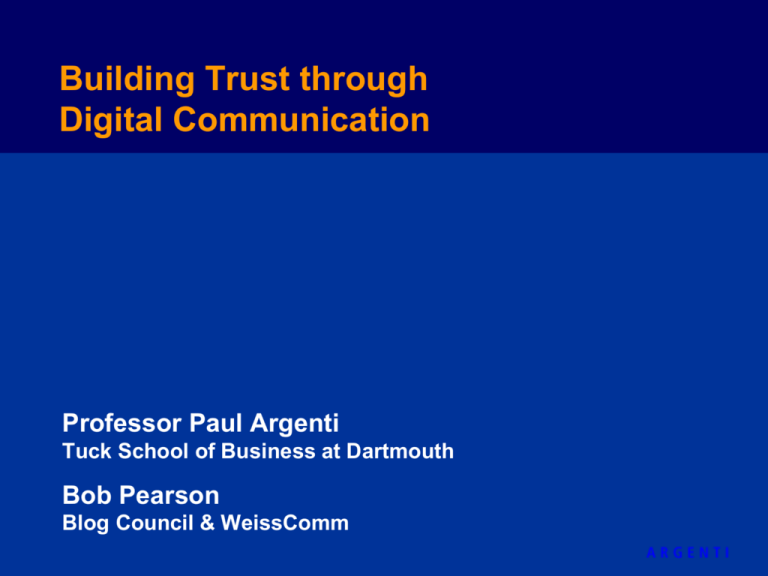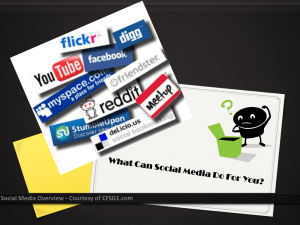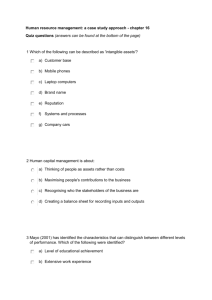Building Trust through Digital Communication Professor Paul
advertisement

Building Trust through Digital Communication Professor Paul Argenti Tuck School of Business at Dartmouth Bob Pearson Blog Council & WeissComm “Trust is like the air we breathe. When it’s present, nobody really notices. But when it’s absent, everybody notices.” —Warren Buffett Our System Hinges on Trust Capitalism is based on trust—when broken, credit markets seize and consumer spending grinds to a halt. As a result of the global credit crisis, the credibility of the capitalist system is being seriously challenged: • Alan Greenspan, dubbed the "greatest banker who ever lived,” admits to misunderstanding market mechanics • Iconic CEO Jack Welch admits focusing on share price was dumb • The Financial Times runs a major new series "The Future of Capitalism" calling into question the effectiveness and survival of our modern business system Source: “Rebuilding Trust in Business,” Bronwyn Fryer, HBR blog, March 17, 2009 Does Business Act Responsibly? 0% 25% 1968 1976 75% 70% 15% 1985 2008 50% 30% 20% Yankelovich & CNN/USA Today/ Gallup Poll 100% Tainted Reputation by Financial Association • Trust, reputation, and image have become increasingly difficult for financial corporations to control • In the wake of billion-dollar government bailouts and year-end bonuses, the public has been quick to judge all players in financial services—and their employees—as pariahs “I’d almost rather say I’m a pornographer—at least that’s a business that people understand.” –Retired Wall Street executive who asked to remain anonymous “Oh, you’re one of THEM…” –Comment to a recently laid-off JP Morgan Chase employee “Wall Street’s New Pariah Status,” The New York Times, February 3, 2009 “Can I interest you in a faith-based account?” –New Yorker, October 2008 Identity, Image & Reputation Drive Trust Corporate Identity Names, Brands, Symbols, Self-presentations is perceived by… Customer Image Community Image Investor Image Sum of their perceptions equals… Corporate Reputation Employee Image Why does Reputation Matter? Price Advantage Competitive Advantage Stability Companies with better reputations: • Command premium prices • Pay lower prices • Entice top recruits • Have more stable revenues • Face fewer risks of crisis • Experience greater loyalty internally and externally • Are given greater latitude by constituents: Opportunity to operate • Have higher market valuation and stock prices • Have greater loyalty of investors, less stock price volatility Reputation environment is changing The evolution of communications requires a new approach to reputation measurement Web 2.0 Social Media Buzz Folksonomy Podcasting Wireless RSS Blogs Operations Media relations Tagging Grassroots outreach Press IR releases YouTube Search engines Promotions Pitching reporters Management and Strategy Online outreach Wikipedia New Communication Traditional Communication Third party outreach Special events Brand management Government Relations Viral marketing Advergaming Metaverses Public affairs Branding Facebook Employee communications Content optimization MySpace Syndication Customer Loyalty Finance Consumergenerated content Flickr Social networking Citizen journalism Recruitment, Retention Defining Social Media Social Media is the democratization of content and the understanding of the role people play in the process of not only reading and disseminating information, but also in sharing and creating content. • Communication in the form of conversation, not monologue. • Participants in social media are people, not organizations. • Honesty and transparency are core values. • It's all about pull, not push. • Distribution instead of centralization. Web 1.0 vs. Web 2.0 Web 1.0 Web 2.0 Collective Intelligence Published Content User Generated Content Published Content User Generated Content Web 1.0 vs. Web 2.0 Web 1.0 • • • • • • Web 2.0 Push business models Commercial software Customer service Bestseller products Traditional media 1on1 customer relationships • Centralized product development Institutions • • • • • • Pull business models Open source software Customer self-service The Long Tail Social media Customer community relationships • Decentralized product development Shift of Control Communities of Individuals The Fundamentals of Trust • Trust is more emotional than logical—it extends beyond rational thinking • Trust is highly personal—no universal standard exists • The notion of trust is based on: − Predictability: you know what you’re going to get − Leaps of faith: you’re willing to deal with someone despite incomplete knowledge of them − Exposed vulnerabilities: you enable someone to take advantage of your vulnerabilities but expect they won’t − Blind belief: you rely on someone to follow through without the need for constant oversight or questioning If tarnished, trust is exceptionally hard to restore How Can Companies Bridge the Trust Divide? • Trust is not only about following baseline rules, procedures, and protocol—that’s only the beginning • Trust is a direct by-product of a company’s relationships of interdependency with its diverse and inter-connected constituencies • To build trust, a company must not be authoritative but authentic in all of its dealings with constituencies • One current way: Through use of social media Source: The Authentic Enterprise, Arthur Page Society, 2007 Becoming an Authentic Enterprise by Embracing Social Media Companies become authentic by: • Dealing with constituents openly and candidly—forging partnerships as equals with constituents • Honestly communicating the unique qualities that set the organization apart from the competition and will truly add value to customers • Clearly conveying the values that define the organization—the underlying principles that underpin every action taken by employees and the organization as a whole • Making promises and never failing to keep them • Admitting mistakes when made and reiterating how they will be prevented the next time around • Social media enables companies to communicate authentically What Do Leaders of Great Brands Understand About Building Trust Online? #1: Customers are co-shaping your reputation everyday Are you accidently outsourcing the building of your brand? Customers Shape First Impressions Customers are Changing Faster than Companies • Breadth: 500k new online customers each day • Location: >40% of online in Asia • 1st Impressions: YouTube Is 2nd largest search engine • Habits: Brazil one of leading consumers of online info Are you a student or an observer? Countries’ Habits are Changing as They Mature Online: Brazil #2: Leaders will identify issues before they happen Customers assume we are listening to their issues in real time Patterns are Clues Waiting to Be Found • Patterns emerge before public awareness ‒ A common problem emerges in a forum in Beijing, a blog in the UK and a mention on twitter in the U.S. ‒ Your multi-function hot issues team springs in to action to analyze what is happening and prepare ‒ When the issue becomes public, you are ready with answers • Customers trust us to be smarter on identifying issues • You decide that if a hot issue is defined, it must be solved • Your company continuously integrates online learning’s into key parts of your company (institutional memory) #3: You Realize that Your Customer Does Not Care Where You Want Them To Go Customers are part of their own liquid network Become a friend who can be trusted A Tectonic Shift is Occurring in Where Conversations Occur • Language: Customers speak online in their first language (10 reach 95%) • Location: Facebook, Twitter, Forums • Time of Day: Ex/low volume during day, high volume in evenings Where do your customers like to hang-out, learn and share? 10 Languages Reach 95% of People; Hindi & Russian are Next Trust Builds When You Visit Your Customer in their Home #4: You Know that <1% of a Customer’s Time is Spent Purchasing a Product 99% of time is spent browsing and socializing You build trust by being there when you are needed, not when you need the customer The Real World of Our Customers Online Broadband users spend 1 hour, 40 minutes (48% of their spare time) online, and more than half of this is spent accessing entertainment and communication The Purchase Experience <1% of a person’s time is spent actually purchasing our products Opinions are formed during the 99% of time outside of the purchase path E-Commerce Will Become E-Community • Reality: <1% of time is spent buying online. 99% is spent browsing & socializing • Peer Influence: 3 of 4 customers look to their peers for advice on a purchase • Integration: Why would we ask a customer to go to multiple sites? The value is…….? Convergence is led by convenience #5: You Focus on How People Consume Content & Understand How it is Changing Customers decide where they will learn It is not via advertising… The Media World isn’t Changing… it Changed • Media Outlets: 74 of top 100 outlets for Techmeme are blogs/online sites • Bloggers: 3 of 4 look to each other for their next story • Customers: 3 of 4 look to each other for purchase advice • Conversations: are the driver of SOV, influence and recommendations Don’t define it as offline or online. It’s all one media world. Just know which conversations are defining your brand The New Media 32 Your Broadcast Station: Increasingly, the 1st choice for learning #6: Your Customer is Discussing Your Brand Everyday Do you know where they are occurring? Are you a participant or observer or are you absent? How Does Your Customer Discuss Your Brand? Dynamic Drill Down 1. River of News 2. Topic Trends 3. Conversation Cloud 4. Language 5. Media Type 6. Post Tag 7. Region 8. Sentiment 9. Source Tag 10. User Assignment WHAT DOES THIS TELL ME? Top 50 most mentioned words in conversations surrounding “Pharmaceutical” over the past 30 days. Do You Know Where The Real Traffic Is? • Allstate insurance: 3.99MM OR • Insurance quote: 31.99MM • Allstate insurance company: 943k • Insurance group: 22.3MM • Geico.com: 1.83MM • Home insurance: 75.8MM • Geico insurance: 1.77MM • Auto insurance: 64.8MM • State Farm insurance company: 4.9MM What is Being Said About Your Brand in Each Key Language? #7: There Isn’t a Destination for a Customer Visiting your site is not their goal, no matter how pretty it looks We are expected to just sort of “be there” when needed Syndication of Content Matters More than Site Traffic • Micro-Communities: The social media world grows & fragments, simultaneously • Customer-Driven Preference: “I want what I want where I want it”. Stop “spamming me”. • Participation is a Choice: If companies don’t listen, customers vote via lack of traffic and participation. What is your content syndication plan? 10-20% of Your Customers Will Call You Each Year Due to a Problem 80-90% will not call you despite a problem Few will call you just to catch up Q&As Matter • Word of mouth matters • Partnering with customers matters #8: Customers Want to Do Three Things to Help Each Other You build trust by being part of this process Ideas, Knowledge, Solutions 1. Share ideas: Let’s improve the next product or service together 2. Share product knowledge: Here is what I know…hope it helps you 3. Help peers with problems: I had the same problem, here is what I did Dell IdeaStorm: Over 11,000 Ideas & 325+ implemented Think Big: Empower Your Customers to Share Knowledge and Benefit the World Solved button added to Original Post; clicking it will take user to Accepted Solution Accepted Solution post Turns green and logo added #9: We don’t have to measure trust internally, we live it Our employees feel free to help each other and, as a result, our company Leverage the world’s greatest operating system – the web Employees Don’t Change When They Arrive for Work • They prefer blogs • They like to share ideas and comments • They want real-life video, not canned productions • They want to help each other, not be polite to senior management and hold in their thoughts #10: We Judge a Person on How They Interact with Us Guess what...customers do the same thing when they shop with us online Shopping is Changing Permanently • Ratings & Reviews: Your peers define the brand and experience for you • Co-Browsing: Your peers help you shop • Contextual Content: Info you want appears when you discuss it Individuals in companies can have the respect of peers. How many “company peers” do you have? #11: We Listen to our Customers, So We Create New Communities Think outside the box, then get rid of the box A community-driven Site Customers Prefer Content That Helps Their Businesses Partnering with Customers Free Recycling add $0 Support Reforestation: “Plant A Tree for Me” [add $2] Recycling Kit and “Plant A Tree for Me” [add $2] #12: We Know Preparing for Yesterday is Ineffective Old models and habits hold back innovation Watch for “antibodies” Ask Yourself if You Know the Answers to These Questions • Since mobile will be the leading source to go online in the next few years, our mobile plan will do… • Since ten languages reach 95% of the online world, we are having conversations with customers in x today and y in the U.S. alone • We know Facebook is growing fast, but we’re also participating in x, y and z properties, since they have high potential • In China (or France or Czech or Brazil), we are active in the local sites, such as Toudou, since they are the online leaders in their country for video (or photos or search or other) • We know the world’s greatest operating system is the web, so our employees can now access all competitive information in real time by xyz tool on abc platform Yesterday’s Thinking Leads Us to Place High Value on Depreciating Assets • The Top Rankings Matter: Mainstream media is decreasing in total SOV online • The Brand is King: Personalities drive brands more than brands alone online • The World is Important, But We Really Focus Mainly on the U.S.: 53 countries have English as a language and see similar content • High Brand Awareness is Good, We’ll Build Brand Value in the Future Locally: Your brand is being shaped by your customers now • Customers Count on Us: Nope, they count on each other, not you Observations on the Old School • They are old school, but don’t realize it • They think tweaking the media mix will work • They wear ties, sound smart and have an answer for everything and often represent yesterday’s thinking • They are planning to succeed in a world that won’t exist in a few years • They like to “content dump” to get rid of their messages in hopes someone will find it #13: We Understand Ethical Behavior is a Key Part of Maintaining Trust We don’t support Flogs or Splogs We would never create a fake ad, so why a fake blog post? #14: We know that leaders will enter and become relevant in conversations that occur everyday in every language all around the world in communities of importance to our customers Companies that cling to the past may not realize it, but they will lose relevance MESSAGE EXPERIENCE CONVERSATION RELATIONSHIPS AFFINITY & TRUST WE BECOME CONVERSATION ARCHITECTS Key Coordinates • The Blog Council: www.blogcouncil.org • My personal blog: www.csmg.us • Everything else: www.twitter.com/bobpearson1845




